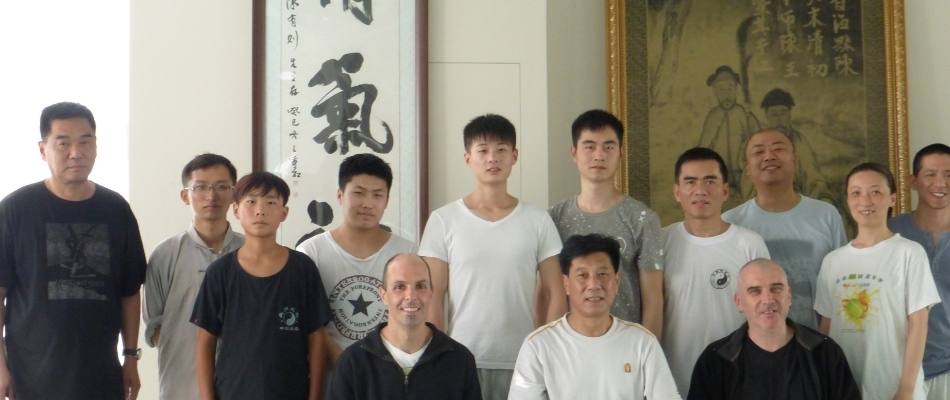In a conversation with a pretty dedicated student I was surprised to hear that she felt a bit lost and was unsure where here tai chi training was going and what she should be focusing on. It’s true that tai chi doesn’t have an extremely regimented curriculum and it can be hard to see where you are or what you should be doing to improve.
Tai chi training is a transition that begins with learning the movements and learning about internal development. It progresses on through learning weapons forms, martial applications, and often push hands. Many go on to attend workshops, teach, and even attend workshops or study in China.
Let’s take a journey from being a brand-new student to someone who has been at it for a while. What you will see is that there really is no finish line but there is a lot of fun to be ha along the way.
Beginner Tai Chi Training
The saying “you don’t know what you don’t know” is never more applicable than when someone starts their tai chi training journey. The movements, pace, vocabulary, and focus are so much different than anything most people have done. A lot of people make a comparison to yoga which is partially okay but the truth is that yoga has static postures and someone is telling you what to do the whole time.
The good news is that you only have one singular goal when learning tai chi: focus on learning the moves of the form and putting them in the right order.
That’s it.
As you are learning the moves, the fundamentals of tai chi will be taught along the way so that by the time you can complete the form you will have improved:
- Balance
- Concentration
- Breathing
- Moving
- Coordination
- Posture
These physiological improvements are baked right into the tai chi training so that by learning the form, you will be moving differently.
Tai Chi Training that Includes Weapons
You might be surprised that tai chi training does and should include weapons at such an early stage. I used to think that a student should really have the open-hand form down, be working on internal development, then possibly start weapons. But then I started to see how much faster progress students were making when they began learning weapons after learning the short form.
It wasn’t just that their form looked better, they themselves were making connections between how they should be moving. They were also connecting the dots between moves in different parts of the form that related to weapons training and making improvements there. And here’s the really cool thing, many don’t completely learn the weapon or aren’t that passionate about it. Just the process of learning something similar and having something in your hands to give you feedback made all the difference. If you are interested in training tai chi weapons I wrote an introduction about it.
Here is a fun example of what learning a weapon looks like. I jumped to a place in this video showing a Taoist tai chi master training sword with a student. It is a good example of how the details of the form are improved after you learn the initial choreography and also how the moves from weapon forms help to improve our movements from the open hand forms.
Tai Chi Power Training for Internal Development
Once a person has the choreography of the form memorized, it is time to start improving each movement of the form and connecting them into one flowing pattern. It feels great to be able to successfully perform the form and you are rewarded by having a foundation that you can use to start building your health and strength by developing internal energy.
What sets Tai Chi, Xing Yi, and Ba Gua Zhang apart as internal martial arts is the fact that there is internal energy or internal power training that drives the motions of the external body. As philosophical or mystical as this might seem to someone not familiar with tai chi, it is actually a physiological discussion.
Tai chi power training is pretty straight forward. It is “foreign” because most of us have never discussed this in gym class, sports we have done, or even other martial arts. Here is a great two-minute teaching session with Master Chen Zhonghua on how to concentrate on moving and generating power from the center.
Tai Chi Martial Arts Training
Tai chi martial arts training is the next essential component once you are generally moving in the right directions. It is essential even if you have no interest in fighting or martial skills because it has a lot to teach about posture, intent, and positioning.
To tell someone where to put their hands and feet is one thing. To tell them that they are pushing someone, or holding an arm, or breaking a hold completely changes their posture and positioning of the body. Having a basic idea of the martial intent of a move also changes their positioning because we hold very different stances when confronting someone or if we are trying to keep our balance when pressure is exerted against us. Here is what an applications class can look like.
Tai Chi Push Hands Training
For those that are interested in tai chi martial arts training and in having a bit of fun, push hands is an activity that starts out dance-like and progresses on to competitions. Tai chi push hands training starts softly with single-hand contact, moves on to two hands, then fixed stance patterns, and moving patterns. It’s really entertaining to watch and take part in and dramatically improves balance, stability, and remaining relaxed while moving.
Tai Chi Instructor Training
At the point where you have accumulated enough knowledge to share, it’s time to start paying back into the tradition that you have benefitted from. For most, this starts by helping out the tai chi beginners in class. Even if this is all you do, it is so helpful to really test how well you know something by trying to show someone else.
The next step is to lead a class when the opportunity arises. For our community, students who want extra practice outside of class plan informal meet-ups and the most senior person is the de facto tai chi instructor training everyone. Or when the teachers are absent for vacation, the longtime students can keep the class going.
I am not suggesting that you misrepresent your abilities. From a place of humility you can say; “This is what I currently know, if it benefits you, great. And please share your experience.”
There are weekend workshops for tai chi instructor training and also courses online. These are a lot of fun and you get to meet other really dedicated people. Many of the pointers that they share about organizing a class and lessons are really helpful. However, be skeptical about anyone offering (selling!) a certificate for 72 hours of effort. You don’t need a certificate to teach tai chi. You need experience.

Tai Chi Training in China
There has never been an easier time to take advantage of opportunities for tai chi training in China. This might seem too farfetched, or you might me be thinking, not me! But the truth is that hundreds of novice practitioners are visiting China each year. Brand new schools have been built in recent years and offer help with travel arrangements. They even put together fun excursions to nearby sites and monuments.
On my trip to China we attended a brand new school in Shanghai which was an extension of the school in Chen Village. We trained from around 7:30-12:00 when we ate a huge lunch and took a long and needed knap. Then it was back for an afternoon session from 3:30-7:30. In the evening there were classes for local students, many of whom spoke English so we had tea and learned about the school, city and country. Speaking honestly, I was totally scared about going and yes, there were forms that I did that needed a lot of work. But I made huge leaps forward in my development and had an experience I will never forget.

What Tai Chi Training Equipment is Needed?
One huge benefit of practicing this art is that it is relatively inexpensive because there is very little tai chi training equipment. Where comfortable clothes and please, please wear shoes without an elevated heal. I explain why here and that will only set you back about $25 US.
Aside from that, it depends on where you are on your journey above. Once people have learned the form, they are usually interested in finding books or resources to learn more. Tai chi beginner weapons forms only require cheaper practice weapons. After learning a weapon form, they often buy a nicer one and a uniform if they are considering demonstrating or entering a competition. These needs vary greatly from person to person so I grouped all books resources, and tai chi equipment on one page.


